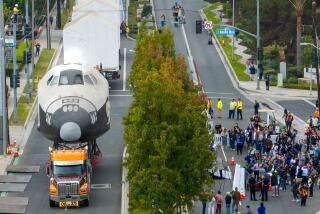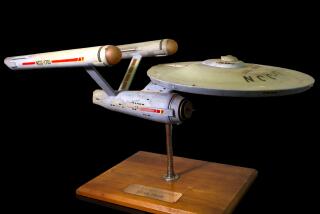Meet ‘the original shuttle’
When NASA officials were mulling over where to send each of four retired space shuttles, no fewer than 21 museums across the country fought to land one in their cities.
Some of the best-known museums in the country put forward elaborate plans on how they could afford the multimillion-dollar undertaking of displaying such an outsized piece of space history. In the end, the winners were largely expected: New York; Washington, D.C.; Cape Canaveral, Fla.; and Los Angeles.
This week, officials in the city of Downey turned their attention to another shuttle, long forgotten to most of the world. Sitting in a nondescript warehouse in Downey, under a coat of dust and waves of plastic sheeting, is a full-scale mock-up -- largely made of wood and plastic -- built in 1972 by shuttle manufacturer Rockwell.
For decades, the 122-by-78-foot model has remained hidden away at the former manufacturing site that was the cradle of the nation’s space program. But that’s set to change. On Tuesday, the Downey City Council approved the temporary relocation of the mock-up to a large tent on a nearby movie studio parking lot where, starting late this summer, people may be able to catch a glimpse of it.
“Except for some school trips years ago, it’s never been open to the public,” Downey Councilman Mario A. Guerra said.
In recent years, only a chosen few visitors have seen the model. They were led by flashlight through a vast warehouse that has no water or power. On the way, they stepped through three chain-link fences with padlocks before arriving at the foot of the shuttle enveloped in protective “house wrap.”
Against the pitch-black backdrop of a million-square-foot building, the shuttle looks like a giant wrapped-up Christmas gift.
“We’ve been dreaming big about displaying it, but we just haven’t had the funds,” Guerra said. “We plan on restoring it for kids to have the ability to actually get in it and sit at the control room onboard.”
For Downey, now a sprawling suburb of more than 111,000, the model is a symbol of the city’s thriving past as an aerospace center. Aircraft manufacturing boomed there during World War II, with factories churning out P-51 Mustang fighter planes around the clock.
After the World War II work dried up, the nation was caught up in the Cold War and set out to put a man on the moon during the Mercury, Gemini and Apollo programs. The country again called on engineers and technicians in Downey to help accomplish its goals. They built the command module that enabled Neil Armstrong and Buzz Aldrin to walk on the lunar surface.
In 1972, Downey received the contract that became synonymous with the city itself when North American Rockwell -- later Rockwell International and now part of Boeing Co. -- was named the primary contractor for the world’s first reusable winged orbiting spaceship: the space shuttle. It was here that about 12,000 people, stretched over 120 acres in 40 buildings, worked and manufactured the shuttle at the program’s peak.
Boeing closed the plant in Downey in 1999. It was sold to Industrial Realty Group in 2003, with a contract requiring the company to keep the mock-up on site. But now a $500-million shopping center is being planned, and the mock-up must go.
Officials hope that the public can see the model under the new tent within the next three months, and that eventually it will become part of a new planned exhibit at Downey’s nearby two-story Columbia Memorial Space Center. A hands-on learning center on space science that opened in 2009, it is an official national memorial to the crew of the space shuttle Columbia, which broke apart on reentry in 2003, killing all seven on board.
But the model has been sitting for decades already. It’s disassembled and locked away in the warehouse without a door big enough to have it moved out -- a wall is going to have to be taken apart so it can be relocated.
The city and the current property owner plan on spending about $157,000 for the mock-up to be moved out of the warehouse and into the tent.
It’s a temporary fix -- just for a year and a half. This should give the city enough time to raise funding for a permanent home, said Guerra, who noted that the five-person City Council voted unanimously for the move.
They need to act soon. The years of indecision have taken a toll. In 2003, Griswold Conservation Associates, an artifact conservation company, was contracted to produce a technical report of the model’s condition, and it found that deterioration was already underway.
“The outer skin of the shuttle, made of plywood on a wooden frame, is buckling slightly and showing signs of internal delamination,” the report said. “Clear plastic, prismatic ceiling panels have fine crazing cracks, and are starting to become detached at their fasteners.”
Scott K. Pomrehn, executive director of the Columbia Memorial Space Center, estimates that it will take $2 million to properly put it on exhibit. To get the money, the center tried to obtain a Save America’s Treasures grant last year from the National Park Service. That didn’t work.
The Downey shuttle is a historic gem, Pomrehn said. “The bottom line is this is the original shuttle. The one Rockwell sold NASA on. And it has been sitting in the dark.”
In the early 1970s, Rockwell decided to build a full-scale mock-up as part of the proposal effort. At the time, the world had never seen a winged space plane before. Before the shuttle, astronauts reached space by squeezing into a small capsule launched atop a massive rocket.
“It would be used for marketing our design approach to NASA and also be an engineering aid to our designers and manufacturing engineers,” said Gerald Blackburn, a former shuttle worker and now president of the Aerospace Legacy Foundation, a nonprofit organization of former aerospace employees who work to preserve Southern California’s aerospace history.
“It was made out of wood, but was built with a craftsman’s touch,” he said. “It served us and NASA well.”
--



